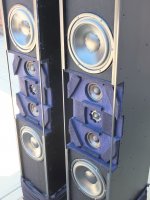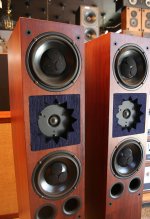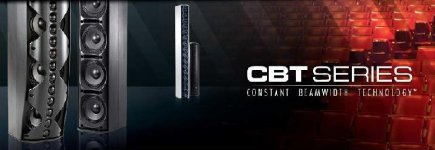Seems like an example of moving away from a true high-end solution IMO. They could have used a midbass horn to match the directivity of the older bi-radial horn. But obviously that makes it too big to market.
Actually...
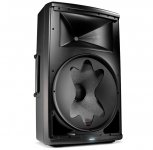
Sprinkle solved that one too. Methinks this innovation isn't in the M2 for a couple of reasons:
1) Sprinkle didn't invent it until later. You notice this with his designs, arguably the newer designs are more evolved than the M2. I believe Sprinkle is fairly young; his LinkedIn indicates that he got his degree in 2003. (It also indicates he left JBL three months ago 🙁 🙁 🙁 )
2) It would be hard do sell this to hifi people. They're going to take one look at that goofy looking aperture and think "no bueno."
Last edited:
Would love to see an impulse of that...
On first sight it spells: "diffraction" to me...
One could call it a band pass port... 🙂
On first sight it spells: "diffraction" to me...
One could call it a band pass port... 🙂
A CBT array approximates the behavior of a point source.
This is not exactly true since a CBT is constant in only one plane. A waveguide approximates a point source with directivity, but a CBT doesn't.
I'm too lazy to dig up my measurements, but here's a measurement that Geddes did of his oblate spheroidal waveguide from the Abbey. Note how it's smoother off axis than on. That behavior seems to be typical of waveguides.
Of course, Geddes probably knew this, and that may have contributed to his setup recommendation, which is to listen to his speakers off axis.
Waveguides will only show an axial hole if they are round and highly coherent. Square ones won't do that. And the hole is different for all waveguides - the NS15 waveguide has virtually no axial hole and the Nathan had a smaller hole than the Abbey. The Abbey was worst case.
I always intended to listen off axis (I used top do that with my JBL 4430s) because it gives you an asymmetric polar response at the listening position - just like the JBL that you showed. So I never worried too much about the axial hole since one should never be listening along this axis.
Would love to see an impulse of that...
On first sight it spells: "diffraction" to me...
One could call it a band pass port... 🙂
It would create diffraction, but then the polar response of a disk is caused by the diffraction of the edge of the disk. (And this diffraction would widen the horizontal polars.) Diffraction is not an issue when it is very close in time to the radiating wave. Its when it is delayed in time that it gets so audible.
"big mistake" is a little harsh. CBT arrays are just different. A CBT array approximates the behavior of a point source.
This is particularly nice for prosound; I'm so sick of going to concerts where the line arrays are melting your face in the front row.
If you've heard a CBT, they have a surreal ability to sound the same no matter where you are. The Danley SH50s do this too. It's very odd that you get closer and closer to the loudspeaker and the speaker doesn't seem to get louder. With an SH50 you can stick your head in it, and it's not particularly apparent where the sound is coming from.
Basically if you want to put sound in a room and you want even coverage, CBT is tough to beat.
They are admittedly less efficient. But power is cheap and you can make a CBT with very cheap drivers (since you're using so many.) You can get twenty 2" drivers from Tymphany or AuraSound and achieve power handling of around 50 watts with a CBT, at a total cost of about $200 per side. That's good performance for not a lot of money.
I should have been more clear. Curved line arrays definitely have their place in large spaces for large audiences. What I don't like is the amplitude "shading" of the drivers near the ends of the array. I read several papers on the subject a few years ago. The main reason being effective cone surface area for low frequencies. For a Hi-Fi system in my home, I'd want a narrow array for better imaging and smaller footprint, which means smaller low frequency drivers, which means shading is not desirable. Plus, if a straight vertical line array goes close to the ceiling and floor, which are acoustically reflective at most frequencies, without shading, then the reflections off the floor and ceiling effectively extend the length of the array for more filling in of any comb filter effects. This should result in a flatter FR at any listening location in the room. Having said that, there are always real world variables with the acoustics of any listening room. How a speaker acoustically interacts with the listening environment is IMO one of the most important things. As important as the quality of the speaker itself.
It would create diffraction, but then the polar response of a disk is caused by the diffraction of the edge of the disk. (And this diffraction would widen the horizontal polars.) Diffraction is not an issue when it is very close in time to the radiating wave. Its when it is delayed in time that it gets so audible.
Yep. It basically makes the 15" woofer behave as if it was narrower, so that it's a better match for the waveguide. I wonder if Sprinkle was inspired by this:
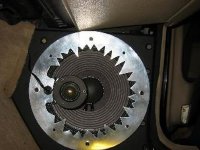
That was in Douglas Winker's car, back when he was competing.
It would create diffraction, but then the polar response of a disk is caused by the diffraction of the edge of the disk. (And this diffraction would widen the horizontal polars.) Diffraction is not an issue when it is very close in time to the radiating wave. Its when it is delayed in time that it gets so audible.
This idea certainly isn't new, as I've seen it being used in car audio some 8 years ago to widen the polar to match a tweeter. That particular case had a irregular multi-pointed metal star mounted in front of the woofer for exact the same reason as it is being used in this JBL example.
The basic idea probably is even older than that, and just received a renewed interest from Sprinkle.
I get the why, I just doubt it is the most effective way to solve this specific problem.
Edit: 😀....John just beat me to it, that's the one, I do remember at least one more external link about it with even more info about that construction. I seem to recall this particular example was inspired by yet another example.
Last edited:
If you don't need the speaker to play full range, I literally can't think of any drawbacks.
Douglas Winker is the first to do it, as far as I know.
Then NEXO started doing it on their prosound speakers.
I don't know if Sprinkle copied Winker, or NEXO, or came up with it on his own. But it works.
It looks a little bit silly but it works.
I don't think diffraction is an issue because these wavelengths are long. The JBL is crossed over at something like 1500Hz. That's 23cm long.
Douglas Winker is the first to do it, as far as I know.
Then NEXO started doing it on their prosound speakers.
I don't know if Sprinkle copied Winker, or NEXO, or came up with it on his own. But it works.
It looks a little bit silly but it works.
I don't think diffraction is an issue because these wavelengths are long. The JBL is crossed over at something like 1500Hz. That's 23cm long.
Duntech did something similar with HF.
I think there were models* where the 'star' was a lot smaller, and partially covered the tweeter dome ...but these are the best example images I can find now.
*maybe someone other than Duntech? - I'm digging up an old memory here.
I think there were models* where the 'star' was a lot smaller, and partially covered the tweeter dome ...but these are the best example images I can find now.
*maybe someone other than Duntech? - I'm digging up an old memory here.
Attachments
Every line array that I've ever heard that had a seperate tweeter line array exhibits this issue[horizontal polar issues]. Once I noticed it, it kinda made them unlistenable really. I mean, they do lots of things right, but I could never get over that.
I’m wondering if this is because every line array you’ve listed to has severe horizontal combing distortion. Typically the Haas Effect should fix this, but maybe there are other effects too. When the distance between the edge of the ribbon tweeter and the center of the mid is on the order of 5-6 inches, that may be a problem for the horizontal polar response. I don’t know.
However my new line array will have the mids being 2.5 inchers, and the ribbon planars will be so close to the mids that the distance between the center of the mid and the edge of the ribbon will not exceed 1.70 inches. Effectively this will make the tweeter and mid lines almost on top of each other. Integration will be extreme at a distance of 10 feet.
You also mentioned the damage that passive crossovers do to the sound lines. Using an active cross at 24 db L-R will fix that.
Finally, most line arrays cross right in the middle of the most sensitive area to the human ear(300-3000), usually at about 1600, which tends to make vocals difficult to understand and messes up a lot of other stuff. The use of a 2.5 inch mid means that it will cover the whole distance from 500-5000 without having a crossover(active or passive) fooling around with the clarity in the critical ranges.
Last edited:
Finally, most line arrays cross right in the middle of the most sensitive area to the human ear(300-3000), usually at about 1600, which tends to make vocals difficult to understand and messes up a lot of other stuff. The use of a 2.5 inch mid means that it will cover the whole distance from 500-5000 without having a crossover(active or passive) fooling around with the clarity in the critical ranges.
I think also that line arrays suffer from a situation that regular speakers often do not. In very few to none, line arrays, the mid ranges are not physically separated from each other in the back. This means that all the back wave from all the speakers mixes together and goes through the front speakers. This will, in my experience, dramatically reduce the clarity of the midrange, and screw up the harmonics that the tweeters are providing for the midrange. And so the integration of the mids and the tweeters will suffer badly.
If the midranges are completely isolated from each other, and the enclosure for each is a long tube stuffed with 4lb cu ft pink fiberglas, there will be no sound coming back through the speaker out of phase to mess up the clarity of the midrange, because it will all be absorbed by the fiberglas. This absorption turning the sound to heat is a documented factor that happens much more easily with pink fiberglas than any other kind of stuffing(see Vance Dickerson’s Loudspeaker manuals). And since it is a tube the sound will be directed back directly and not all over the place. This also simply eliminates half the harmonics from the back wave due to the physics of sound propagation in closed tubes.
And so additionally, the only primary tones and harmonics that are coming out of the midrange will be out of the front by that speaker, and thus the frequencies will mesh appropriately with the harmonics of the tweeter.
Last edited:
I get the why, I just doubt it is the most effective way to solve this specific problem.
To me the problem isn't how to get the pattern wider, its how to get it narrower*. So even if it is effective, its not the problem that interests me.
* - the upper limit of DI in a loudspeaker system is usually the DI at the top end of the woofer - assuming CD is the goal - so widening (higher DI) is going in the wrong direction.
the distance between the center of the mid and the edge of the ribbon will not exceed 1.70 inches.
Its the center-to-center spacing that determines interference, not the edge(s).
Finally, most line arrays cross right in the middle of the most sensitive area to the human ear(300-3000),
That is not exactly correct. Greisinger quotes 700-7 kHz as the most sensitive to aberrations. 300-3k is where the phone company found that signals need to be present for best intelligibility - different things.
The ears sensitivity peaks at 2-3 kHz.
To me the problem isn't how to get the pattern wider, its how to get it narrower*. So even if it is effective, its not the problem that interests me.
* - the upper limit of DI in a loudspeaker system is usually the DI at the top end of the woofer - assuming CD is the goal - so widening (higher DI) is going in the wrong direction.
I thought I'd pull some data from the spec sheets, comparing the JBL speakers WITH the RBI and those without.
Unfortunately, it looks like JBL stopped publishing the polar response for these quite a while ago.
Filling the cavity with foam would cost you a couple dB in output but would reduce diffraction at the edges of the baffle. Similar to what Charlie Hughes did in his Quadratic Throat Waveguides at Peavey.
That should minimize it. Maybe I should buy a pair to test sometime. But right now I'm working with Don Keele on an improved CBT version. Should be some steps above CBT24 and CBT36.
Last edited:
- Status
- Not open for further replies.
- Home
- Loudspeakers
- Multi-Way
- Floor-to-ceiling array vs CBT
